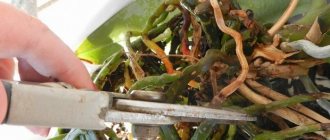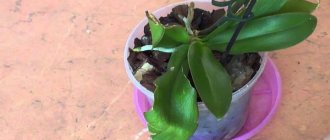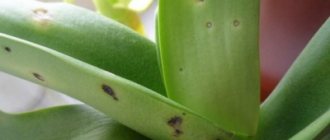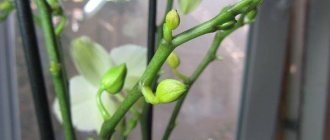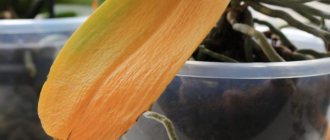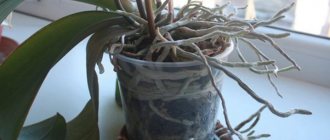Features of the root system
Orchid aerial roots are roots that grow outside of the potting medium. They can grow from stem nodes at the top of the stem or emerge from potting soil. Some orchids produce many aerial roots, while others have few or no roots.
Orchids are natural epiphytic plants. This means they grow on other plants rather than in soil. Roots are responsible for anchoring the plant in place of growth, as well as for absorbing necessary water and nutrients.
Aerial roots are not that rare. But if you are new to growing phalaenopsis orchids, this term may not be familiar to you. The appearance of roots above the surface of the pot does not mean that the orchid has become cramped in the pot and needs to be replanted - just air outlets have begun to grow in the plant.
Also find out what to do if the peduncle of an orchid has dried up.
Structure
The structure of phalaenopsis aerial roots is very different from the structure of ordinary roots of land plants. The spongy tissue velamen covers the inner filamentous part of the root with a thick layer of epidermal cells. Velamen helps orchids cling to tree branches, absorb water and nitrogen from the air , protects them from damage and retains moisture, thereby providing water to the entire plant and protecting it from drying out.
Aerial roots are natural to epiphytic species that grow on other plants in tropical forests. Unlike terrestrial orchids, which root in the ground, epiphytic species naturally grow above ground, using their roots to attach themselves to tree branches and reach brighter areas among the foliage.
Unlike other plants that attach themselves to trees, phalaenopsis orchids are not parasitic or invasive. Epiphytes, with a unique root system, use their roots to absorb nutrients, moisture and carbon dioxide to grow and survive directly from the air, without feeding on tree sap .
We recommend reading how to propagate an orchid from cuttings at home.
Appearance
Although aerial roots do not improve the aesthetic appearance of the flower, nothing needs to be done with them - this is the natural development of the plant. They are cylindrical or flat in shape and should be firm to the touch.
The aerial roots become bright green immediately after watering, which is a sign of healthy roots. As they dry, they first turn silver and then gray or whitish, which means that the orchid may need watering . Just soak the roots for 2 minutes or spray them with water and they will turn green again.
Features of the orchid root system
Many exotic plants, including orchids, have aerial roots. Their main function is to store moisture and subsequently use it. The roots hang from the trees like a thick “beard”, and they are also used to attach them to the support. During drought, the plant extracts moisture from the air. The porous surface layer of the roots absorbs water molecules and forms a moisture reserve. With the help of roots, the flower grows and moves - the mechanism is the same as that of vines.
According to professionals, all the roots of a flower can be called aerial. Of course, there are differences between them. Those that extend outward (beyond the surface of the pot) have a denser surface consisting of many layers. Sometimes there are too many of these roots, and the reason is waterlogging. If the rules of watering are not followed or there is more moisture than required, then the orchid literally begins to grow its roots in different directions. In this case, the amount of watering should be reduced, as this can lead to rotting and death of the plant.
The reason for the appearance of aerial roots
The growth of a plant and its root system is a natural cycle of development and renewal, so the appearance of new roots more often indicates the healthy and proper development of the orchid . The appearance of 2-3 aerial roots is normal and should not cause concern.
But sometimes the reason for the intensive growth of aerial roots above the potting substrate can be excessive moisture or increased dryness and too warm air (for example, when located next to a heating radiator) - growing out of the pot, the flower tries to find a more comfortable place.
Read more about how to care for orchid roots.
How to trim orchid roots correctly
If you notice that the roots are dry, rotted or diseased, the orchid needs to be replanted. Before this, the root system is carefully examined, trimmed, processed and placed in a fresh substrate.
The work is done like this:
- The orchid is removed from the flower pot and cleaned of the substrate.
- The remaining soil mixture is washed under running warm water.
- The roots are dried.
- Using pre-disinfected pruning shears (or a sharp knife), cut off dry, rotten or diseased roots.
Sometimes it is not easy to distinguish healthy roots from diseased ones. Outwardly they may be similar. To determine the condition of the appendix, it must be lightly pressed. If the root is healthy, it is elastic and will not break. The infected root is soft to the touch, releases viscous mucus when pressed, and breaks easily.
“The Mystery of a Strange Disease of Orchids”, author – G. Gruzinova , magazine “Planet of Orchids”, No. 33(1), 2014.
- The sections are dried naturally by placing the roots on a clean, soft cloth.
- Treat with an antiseptic, such as activated carbon.
- Planted in a new substrate. But if the root system has been severely affected by fungal rot, then before planting it is soaked in a fungicide solution. protective equipment is used :
- Biological - “Fitosporin”, “Alirin”, “Gamair”, “Trichodermin”, “Mikosan”.
- Chemical - “Chistotsvet”, “Quadris”, “Fundazol”, “Skor”, “Ridomil Gold” “Ordan”, etc.
Tip #2 . Biofungicides are used for minor orchid infections. If the disease has gone too far, chemical remedies will be needed.
4. To protect indoor plants from diseases, the same means are used as for open ground.
How are they different from regular ones?
Aerial roots are similar in many ways to normal roots growing in a substrate—it's just a different root arrangement. They are slightly thicker and are the healthiest on the plant, as they grow in conditions close to the flower's natural habitat.
Household orchids are usually grown in a soilless mixture based on pine bark or sphagnum moss to mimic natural growing conditions in trees . Over time, this potting mix breaks down and requires replacement, and the internal roots are at high risk of developing root rot and fungal infections.
The orchid seeks new sources of nutrients, light and moisture, so its roots twist and turn in all directions, but most of them remain in the drainage pot. If the orchid does not have above-ground roots, then most likely when they appear, they are rooted in the substrate
Why does an orchid need aerial roots?
The health of an orchid depends on the condition of its root system. Aerial roots actively participate in photosynthesis and serve to replenish moisture reserves and further use it.
Functions of air roots:
- fastening and support - epiphytes have completely abandoned underground roots and use aerial roots to anchor themselves on tree branches;
- absorbing water from the environment and storing it for use in drier conditions;
- obtaining nutrients from water, air and symbiosis with fungi (mycorrhiza);
- photosynthesis - similar to leaves, they convert light energy into carbohydrates necessary for plant growth.
Did you know? Orchids, known as lithophytes, use a similar anchoring strategy to epiphytic species, but are anchored on rocks rather than trees.
Products for processing orchid sections
There are many means that can be used to treat the damaged area of an orchid. Among them there are medications from a regular first aid kit, and special disinfectant compounds, and folk remedies:
| Treatment agent | Advantages and disadvantages |
| Zelenka | A universal and affordable product that is always at hand. Suitable for processing cuts on all parts of the plant - roots, leaves, trunks, flower shoots. Disadvantage: if handled carelessly, it can cause chemical burns to tissues. |
| Potassium permanganate | A good disinfectant for treating roots. Disadvantages: requires proper preparation of the solution, not very convenient for working with leaves and trunk. |
| Activated carbon | An accessible and cheap product, it dries cuts on trunks well and adsorbs external moisture when it gets on the wound surface. Disadvantages: requires careful grinding, crumbles, making it inconvenient for use on roots and leaves. |
| Cinnamon powder | A popular and cheap product for treating trimmed roots. Protects against fungal infections and stimulates cell regeneration. Disadvantage: ineffective against bacterial lesions, crumbles, not suitable for working with leaves and trunk. |
| "Fundazol" | A strong systemic fungicide that penetrates deeply through the conducting system into the orchid tissue. Disadvantages: provokes the development of resistance of pathogens to fungicides, toxic to humans, does not protect against bacterial infections. |
| "Chlorhexidine" | An excellent antiseptic solution, effective against fungi and bacteria. Heals cuts quickly. Suitable for processing any parts of the orchid - both roots and other organs. Disadvantage - can only be used in low concentrations (0.05%), since stronger ones cause chemical burns to tissues. |
| Hydrogen peroxide | A good product for treating cut roots. Used in 3% concentration. Disadvantage: if handled carelessly, it can cause chemical burns to tissues. |
In addition to the listed drugs, a solution of any copper-containing fungicide can be applied to the wound surface:
- "Oxychom";
- "Abiga Peak";
- "Kuproksat", etc.
“Copper-containing preparations slightly dry out the sections and block the way for fungal spores. But they must be used carefully and moderately so that the orchid does not experience “copper shock.”
L. Vlasova, florist with 14 years of experience
It is also important to remember that fungicides are not a one-size-fits-all solution. They do not protect against bacterial pathogens.
Tip #1. Some gardeners try to treat orchid sections with Furaplast. This is a powerful antiseptic used in medicine to heal purulent wounds and bedsores. However, it forms a thin film on the surface of the plant, which prevents the tissues from breathing. Therefore, if there is nothing else, it is better to replace it with ordinary furatsilin.
Zelenka is the most popular means for processing cuts. When used correctly, it is completely safe for orchids, and its protective properties are very high.
The orchid has many above-ground roots
Sometimes a large number of above-ground roots indicates the need to transplant the flower into a larger pot.
Orchids generally like to be root-bound to the substrate, just like a tree in its natural environment, so most of the root system remains in the pot. However, as the plant grows, the potting medium becomes so clogged with roots that they become crowded and grow outward. In such cases, you should consider replanting the plant.
When not to do this
There are some contraindications for pruning. For example, you cannot cut off the roots when the orchid is in the flowering stage. Although this procedure is intended to improve health, it is stressful for the plant. Moreover, in addition to removing unnecessary processes, it is combined with a forced transplant.
If you do this during flowering, then in most cases it will end immediately. The flower will shed both buds and flowers.
Otherwise, you can choose any time, since the presence of damaged roots can provoke the development of any diseases.
Is it possible to trim and when to do it?
A flower's aerial roots should not be pruned because they are a living part of the system the plant uses to absorb nutrients and water. Trimming aerial roots can cause the plant to become sick or even die due to disease or inability to absorb enough elements to grow.
Important! Any unhealthy roots should be removed to healthy tissue using sterile instruments (wipe with alcohol or heated over fire), and the cut areas should be dried and treated with activated carbon or cinnamon powder.
There are several ways to control aerial roots:
- double pot - the main container with the substrate is placed in a decorative pot, which hides part of the air outlets;
- replanting the orchid into a large container with deepening the roots that have crawled out of the potting mixture beyond its boundaries. At the same time, you should not bury the aerial roots growing on the stem.
Only diseased, dry, dead and damaged parts of the roots should be removed. Trimming is carried out until healthy and clean tissue
How to remove damaged roots
If the air shoots have dried out or begun to rot, then the ear needs to be removed. To do this, you can use sharp scissors or a knife. Before pruning, the tool should be treated with alcohol to prevent infection of healthy plant tissue. Damaged shoots must be removed very carefully. If even a small part of dead elements remains on the roots, they can infect healthy shoots. Upon completion of the procedure, all sections should be treated with charcoal or activated carbon, previously ground into powder.
Important! After pruning the aerial roots, the orchid should not be watered for several days, otherwise the decay process may resume. If the shoot is damaged only in the lower part, then it should not be cut completely, but only to green, healthy tissue.
Problems and their possible solutions
The aerial roots of epiphytes do not require special care - they will also be healthy if you take good care of the flower itself. However, they may experience the same problems as the stems and roots inside the pot.
Why do orchid roots dry out?
If the roots are gray, dry and wrinkled, or there are no growing tips on them, then the orchid is not receiving enough moisture. This may occur due to the coarse fraction of the potting mixture, which does not allow the roots to better contact the substrate when watering.
We recommend reading how to revive an orchid if its roots dry out.
Low air humidity in the room, which often occurs during the heating season, is also the cause of dry roots - you can place a container of water near the plant and spray it regularly. Try to keep the humidity above 40% to prevent the aerial roots from drying out too quickly.
The roots can also dry out when exposed to direct sunlight, especially at midday - try shading the orchid with a transparent curtain or moving it away from the window
Why does the root system rot?
When roots begin to rot, they become brown and soft and cannot properly absorb water and nutrients. The only thing you need to do to help the plant is to trim the rotten roots back to healthy tissue.
Important! Sometimes the roots turn brown due to hard water and salt deposits on their surface. But unlike rot, salt stains are hard and similar to rust.
The causes of rot can be excessive watering and stagnation of water in the substrate, as well as high concentrations of fertilizers and incorrect temperature conditions.
Only aerial roots remain
If for some reason the flower has only aerial roots left, then the following planting option will help the plant recover:
- cut off all problem roots at the base and sprinkle the sections with cinnamon or activated carbon. Dry the orchid in the air for 3–5 hours so that the wounds from the cuts heal and dry;
- prepare a pot according to the volume of the root system with holes for draining water and ventilation;
- use a fine fraction of bark as a substrate, and lay a layer of sphagnum (1 cm) on top, after dousing it with boiling water;
- give the flower a reliable support so that it does not wobble or tip over in the pot, injuring the roots. Place the root collar at the very surface of the substrate - all parts of the orchid should be in the air and not touch the water;
- leave aerial roots on the surface;
- water not by submersion, but by generously spraying sphagnum moss to stimulate root growth down to the moist surface.
Important! The orchid is very tenacious and can survive by using aerial roots.
Moldiness
Mold on a plant can appear due to decomposition of the potting mixture, excessive humidity and high temperature, which leads to the pot fogging and condensation. In such cases, it is necessary to change the conditions of keeping the orchid and dry the substrate.
Mold is sometimes caused by fungal microorganisms, and here you will need to replant the flower with replacement of the mixture and treatment with fungicides
Aerial roots turn black
Blackening of the roots can occur for the following reasons:
- the plant was exposed to direct sunlight for a long time and received burns. Such blackening is also possible on the leaves;
- long-term decrease in temperature (+4...+6°C) with high air humidity;
- watering or spraying with cold water;
- increased concentrations of fertilizers (only a quarter of the specified norm of flower fertilizers is required);
- deposition of salts in the substrate when watering with hard water;
- pathogenic diseases.
Find out what to do - the orchid's leaves are falling.
The need for orchid pruning and cutting processing
Orchids react quite painfully to pruning - this is an acute stressful situation for them. Therefore, if possible, it is better to avoid “surgical” procedures when growing these plants. Pruning is justified only in the following cases:
- pruning roots during the development of root rot;
- pruning leaves when fungal or bacterial infections develop;
- trimming flower stalks after they dry out;
- trimming peduncles while removing babies;
- pruning trunks when the growth point dies;
- pruning trunks during orchid rejuvenation.
Processing of sections is a preventive procedure. It helps prevent the following problems:
- development of infectious processes;
- excessive loss of moisture due to extensive damage;
- water entering the cut and inhibiting the healing of the damaged area.
Thus, processing sections of orchids can be compared to first aid for a wounded person.
Important! The cut formed after the procedure represents a wound surface through which microorganisms easily enter the plant tissue. An orchid experiencing stress at this moment is unable to resist infections. Therefore, helping her is a serious task for the gardener.
Even after proper pruning and good processing of the cuts, the orchid will require rehabilitation, during which the plant needs to be carefully cared for.
Plant care
Caring for orchids is simple and does not require much effort - just learn the basics:
- Most epiphytes require moist and well-drained mixtures . There are several types of nutrient media that can be used for plants - fir or pine bark, sphagnum peat, stones, cork, charcoal, sand. The fraction of the bark depends on the type of orchid being grown - the coarse fraction is suitable for phalaenopsis, but the plant should not be buried.
- The best location would be windows facing east or south - the plants in question prefer diffused, indirect bright light . Lack of lighting leads to poor flowering, and direct rays at midday can cause leaf burn.
- Temperature and humidity are also important for indoor orchids. A temperature of +18°...+25°C and a humidity of 60% throughout the growing season are considered comfortable, but for the plant to bloom, the night temperature must be 8–15°C lower than the daytime temperature.
- The flower is watered by immersion once every 10–14 days. This is the only case when the epiphyte roots remain in water, but for no more than 3–5 hours. It is advisable to use soft or boiled water, with a temperature of about +30...+35°C. The flower should dry well between waterings.
- During the growing season and plant growth, use a weak solution of houseplant fertilizer every time you water it. No fertilizing is carried out during flowering .
- The flower is replanted every 2 years with a complete replacement of the substrate.
- It is necessary to carefully monitor the plants in order to promptly notice signs of disease or pest damage and take action.
- At home, the phalaenopsis orchid reproduces by children , which grow on peduncles or stems. Propagation by seed or tissue culture is best left to commercial growers as it requires special laboratory equipment.
Orchid transplant
Repotting is necessary to ensure good health and optimal growth of the plant. If an orchid remains in the same pot for a long time, the flower will begin to weaken and fade. Over time, the substrate decomposes and becomes compacted, its air permeability is impaired, and the plant lacks air, which will increase the risk of disease and lead to stress.
The frequency of repotting depends on the type of orchid and the type of potting mix. An orchid must be replanted regularly, and phalaenopsis only benefit from frequent replanting. Be sure to use new potting mix when doing this. A composition made from crushed coconut shells will last longer than a mixture of fir or pine bark.
Did you know? Vanilla is the most famous and widely used spice and is obtained from the only commercially grown orchid.
Some experienced gardeners believe that using a mixture of perlite and peat in the potting mix produces fewer aerial roots than pine bark. In any case, when replanting, do not deepen the aerial roots, because they may rot. The new pot for the plant should be transparent and have drainage holes to drain water so that the orchid's roots are not in the water.
An orchid transplant is necessary in the following cases:
- a recently purchased flower is replanted to assess the quality of the roots and general condition, but if it blooms, you should wait until the end of flowering;
- the growth and development of the plant leads to the fact that the pot becomes cramped, and the flower needs a larger container;
- a pot that is too large is also a reason for replanting a flower, since the orchid will grow roots to the detriment of the development of the leaf part and flowering;
- there are signs of disease or pest damage.
The orchid has yellow roots, what to do? So, orchids with light roots:
White on the outside, hollow on the inside.
A common mistake made by inexperienced flower growers: they think that if the root is light, then it is alive, but if you cut the root, it turns out that it is dry and empty inside.
Is yellow bad?
Sometimes the roots, deeply immersed in the substrate, acquire a yellow or even brown tint. The reasons for this are that the roots are in the dark, in addition, the color of the roots can be affected by substances that the orchid absorbs from the soil. In this case, the dark color of the roots in no way indicates a deterioration in the health of the flower.
How to determine whether orchid roots are dead or alive?
If the root is hard and elastic, this is a sign of its viability.
And vice versa: even if the root looks quite healthy, but when pressed with a finger or nail it is easily pressed, then most likely this root is already dead.
It happens that a generally healthy root has a necrotic area somewhere in one place. Such a root is no longer useful to the plant, since it is not able to fully nourish it, and can even cause harm: the dead area can become a source of infection for the plant stems. Therefore, when examining the roots, be very careful.
It is a mistake to assume that if the upper, green part of the orchid is normal, then everything is fine with the roots. The pathogenic process in the roots does not occur at lightning speed, and if you identify diseased roots in time, you will have time to save the orchid.
Causes of root death in orchids:
- excessive moisture, poor lighting, too dry soil in the heat - that is, a violation of the agrotechnical conditions for growing orchids;
- fungal or bacterial infection of the plant;
- advanced age of the plant.
What to do if you find dead roots on your orchid?
First of all, correct mistakes in caring for the plant. An orchid can only be revived in conditions that are optimally favorable for it. A new root system can only appear from new shoots, in turn, new shoots can only come from green living buds. Our first task is to find these same kidneys.

